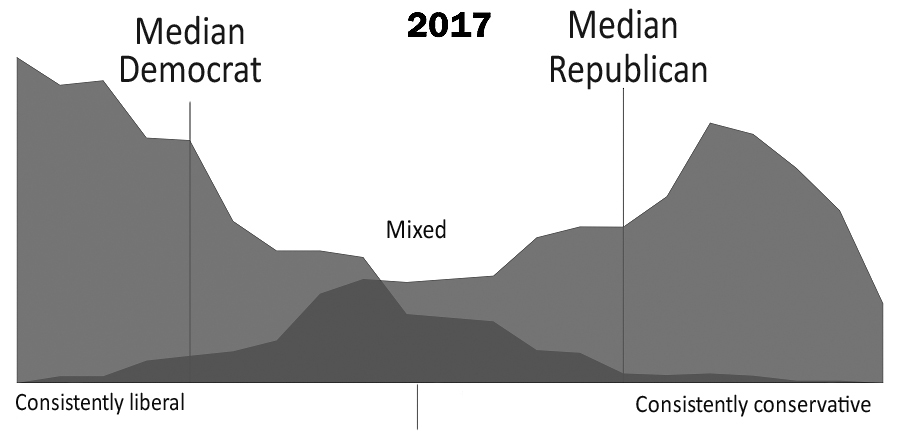Political polarization has been tightening its grip on the United States since the 1970s. Bipartisan bills in the House of Representatives and Senate are few and far between while voters seem to not be able to agree on anything.
Professor of Political Science Keith Poole is mapping the ideologies of members of Congress based on their voting records in order to make sense of this divide.
“What we find is that, since the mid-1970s, Democrats and Republicans in Congress have continued to move away from the ideological center and toward their respective liberal and conservative pole,” Poole wrote. “With almost no true moderates left in the House of Representatives, and just a handful remaining in the Senate, bipartisan agreements to fix the budgetary problems of the country are now almost impossible to reach.”
This polarization is not isolated to politicians.
According to the Pew Research Center, 62 percent of Republicans and 70 percent of Democrats say they are actually afraid of the other party.
These numbers have more than tripled since a report by the same research center in 1994.
Gallup reported that 42 percent of people identified as Independent, 29 percent as Democrat and 26 percent as Republican. They also reported that this was the fifth consecutive year that over 40 percent of Americans identified as Independent.
This information demands us to investigate how we have become this way.
One of the main causes of political polarization is the foundational disagreement, and I want to emphasize disagreement, between parties on facts. Peer-reviewed scientific reports are outright dismissed because the facts do not fit their agenda.
According to the Pew Research Center, about 81 percent of Republicans and Republican-leaning independents say Republican and Democratic voters disagree on basic facts of issues. And, 76 percent of Democrats and Democratic-leaning independents say the same.
We cannot allow this level of criminality to go unpunished.
This amount of willful ignorance is unprecedented in the era of the Internet. Any information you are presented with can easily be checked by a Google search, because let’s be honest no one uses Bing, so long as its checked through a reliable source.
And that’s the next part of the problem; finding reliable news sources.
Through the Internet, or television, anyone can say anything.
News outlets such as Fox News, MSNBC and even CNN are spouting information that reinforces ideas based on political agendas.
We are being fed what we want to hear and we are eating it up like it’s a Harry Potter movie.
The weirdest aspect of news bias is that comedy shows like The Daily Show and Last Week Tonight With John Oliver are the ones who present information with relatively little bias.
Comedy is holding itself to a higher standard than the news networks that supposedly have journalistic integrity.
So in a way President Donald Trump has a point when he yells “FAKE NEWS” on Twitter.
Does he mean it in this sense: probably not.
Since we cannot regulate what a person can, or cannot, say we must regulate ourselves to ensure that our information is accurate.

